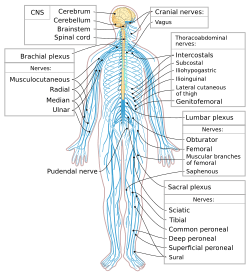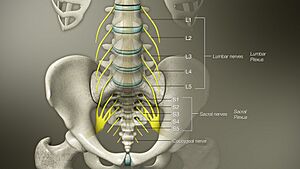Peripheral nervous system facts for kids
| Brain: Peripheral nervous system | ||
|---|---|---|
Quick facts for kids
|
||
| The human nervous system. Sky blue is PNS; yellow is CNS. | ||
| Acronym(s) | PNS | |
The peripheral nervous system (PNS) is a major part of your nervous system. It works with the central nervous system (CNS). The CNS includes your brain and spinal cord. The PNS is made of nerves and groups of nerve cells called ganglia. These parts are found all over your body, outside your brain and spinal cord.
The main job of the PNS is to connect your brain and spinal cord to your arms, legs, and organs. Think of it as a huge network of wires. It sends messages back and forth between your brain and the rest of your body. Unlike your brain and spinal cord, the PNS is not protected by bones like your vertebral column or skull. This means it can be more easily affected by things like toxins.
The peripheral nervous system has two main parts. These are the somatic nervous system and the autonomic nervous system. Each part has divisions for sensing things and for controlling movement. The autonomic nervous system controls things you don't think about, like your heart beating. Some nerves in your head, called cranial nerves, are part of the PNS. However, the nerves for smell and sight are actually part of the CNS.
Contents
How Your PNS is Built
Your peripheral nervous system is split into two main parts. These are the somatic nervous system and the autonomic nervous system.
The somatic nervous system is in charge of things you can control. It sends signals from your brain to your muscles. This lets you move your body. The sensory nervous system is also part of the somatic system. It sends signals from your senses, like taste and touch, to your spinal cord and brain.
The autonomic nervous system works on its own. It controls body functions you don't think about. These include your heart rate or how your digestive system works. It helps keep your body running smoothly without you needing to tell it what to do.
The Somatic Nervous System
The somatic nervous system includes sensory nerves and somatic nerves. Many nerves have both sensing and controlling jobs.
In your head and neck, special cranial nerves carry sensory information. There are twelve pairs of these cranial nerves. Most of them start in your brainstem. They mainly control the functions of your head. One special cranial nerve is the vagus nerve. It gets sensory information from organs in your chest and belly. Another unique nerve is the accessory nerve. It helps control muscles in your neck and upper back.
For the rest of your body, spinal nerves carry sensory information. These nerves come out from your spinal cord. They often form a network of connected nerve roots called a "plexus." These networks then form single nerves that control different parts of your body. Humans have 31 pairs of spinal nerves. They are named based on where they come out of your spine. For example, there are 8 cervical (neck) pairs and 12 thoracic (chest) pairs.
Cervical Spinal Nerves (C1–C4)
The first four cervical spinal nerves (C1 to C4) are in your neck. They split and join together to form many nerves. These nerves help control your neck and the back of your head.
For example, the C1 nerve helps move muscles at the base of your skull. C2 and C3 nerves help you feel and move your neck. They also help you feel the back of your head and behind your ears.
A very important nerve called the phrenic nerve comes from C3, C4, and C5. This nerve controls your thoracic diaphragm. The diaphragm is a muscle that helps you breathe. If your spinal cord is badly injured high up, you might not be able to breathe on your own.
Brachial Plexus (C5–T1)
The last four cervical spinal nerves (C5 to C8) and the first thoracic spinal nerve (T1) join together. They form a complex network called the brachial plexus. This network of nerves controls your arm and upper back. Even though it looks tangled, it is very organized. It helps you move and feel things in your upper body.
Lumbosacral Plexus (L1–Co1)
The nerves from your lower back (lumbar), hip area (sacral), and tailbone (coccygeal) also form a network. This is called the lumbosacral plexus. It is usually divided into three parts:
- lumbar plexus
- sacral plexus
- pudendal plexus
These nerves help control your legs and other lower body functions.
The Autonomic Nervous System
The autonomic nervous system (ANS) controls actions that happen without you thinking about them. It helps regulate how your body works. Your brain and spinal cord connect to organs with smooth muscles. These include your heart, bladder, and glands. The ANS controls things like how big your pupils are or how much saliva you make.
The autonomic nervous system is always active. It can be in either a "sympathetic" or "parasympathetic" state. One state might take over depending on the situation. This causes different chemicals, called neurotransmitters, to be released.
Sympathetic Nervous System
The sympathetic system gets active when you face stress or danger. This is often called the "fight or flight" response. Chemicals like norepinephrine and epinephrine are released. This makes your heart beat faster. It also sends more blood to your muscles. At the same time, it slows down less important functions, like digestion. This system can activate certain parts of your body while others stay calm.
Parasympathetic Nervous System
The parasympathetic system helps your body "rest and digest." It mainly uses a chemical called acetylcholine. When this system is in charge, you make more saliva. Your digestion also becomes more active. Your heart rate and other "fight or flight" responses slow down. Unlike the sympathetic system, you have some control over parts of the parasympathetic system. For example, you can control when you urinate or go to the bathroom.
Enteric Nervous System
There's another part of the autonomic nervous system called the enteric nervous system. This system is found only around your digestive tract. It can control things locally in your gut. It doesn't always need signals from the sympathetic or parasympathetic systems. However, it can still receive and respond to them. The enteric system is responsible for many functions related to your digestive system.
Diseases of the PNS
Sometimes, the peripheral nervous system can get sick or damaged. This is called Peripheral neuropathy. It can affect one nerve or many nerves.
A single peripheral nerve can be damaged. This is called a mononeuropathy. Injuries, trauma, or pressure can cause this. For example, a tumor might press on a nerve. Or, a nerve might get trapped in a small space. Carpal tunnel syndrome is an example. It happens when a nerve in your wrist gets squeezed. This can cause pain and numbness in your thumb, index, and middle fingers.
In peripheral neuropathy, one or more nerves don't work properly. This can happen for many reasons. Diabetic neuropathy is when diabetes damages nerves. Alcohol or certain metals can also cause damage. Some infections or immune system problems can also lead to nerve damage. Peripheral neuropathy can cause a loss of feeling. It often starts in the hands and feet and moves up. It can also cause pain. This type of nerve damage can affect the autonomic nervous system too.
See also
 In Spanish: Sistema nervioso periférico para niños
In Spanish: Sistema nervioso periférico para niños
- Classification of peripheral nerves



